Best Shopify Abandoned Cart Email Strategies To Recover Lost Sales
Running a profitable eCommerce store demands many things. You need to excel in marketing products, managing inventory, attracting website visitors, etc. However, there is one underrated factor that we have seen many business owners overlook - abandoned carts.
There will always be shoppers who add your products to their cart but don’t complete the purchase. And for many, it is one of the biggest leaks in the sales funnel. It is frustrating, too, knowing that you spent a lot of money to gain their attention but no strong buying intention.
What if you have a cost-effective strategy to target these cart abandoners and recover the lost revenue?
By having an abandoned cart email strategy, you can combat this phenomenon, win back those lost sales, and ultimately convert more visitors.
Throughout this article, we will introduce you to the best strategies to implement, plus valuable resources to craft your own campaigns. Let’s get started!
Key Takeaways
- Abandoned Cart Emails Are Essential: Abandoned cart emails are a crucial tool for eCommerce businesses to recover lost sales. Many customers add items to their carts but leave the website without completing the purchase, and these emails aim to bring them back.
- Persuasive Content is Key: Abandoned cart emails should contain details about the items left in the cart, persuasive messaging encouraging shoppers to return and checkout, and possibly offer incentives like free shipping. Simplicity and clarity in messaging are essential.
- Timing Matters: Sending an abandoned cart email within 3 hours of cart abandonment can result in a 50% cart recovery rate. Over the next several days, follow-up emails can recover 15-25% of abandoned carts. Timely reminders are crucial.
What is an abandoned cart email strategy?
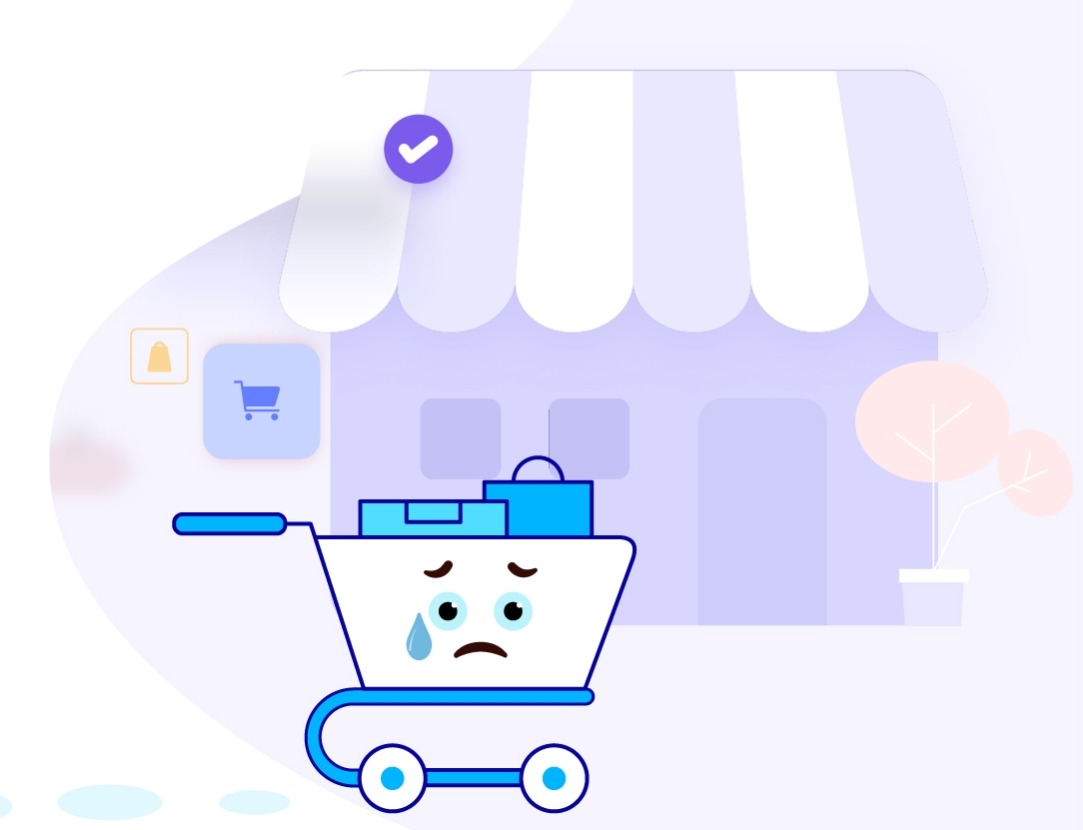
An abandoned cart email strategy is a key tactic eCommerce businesses use to recover sales from shoppers who have added items to their online shopping cart but left the website without completing the purchase. This is a widespread occurrence in eCommerce.
According to Statista, in 2021, the average cart abandonment rate across all online retailers is about 70% - meaning nearly 7 out of 10 online shoppers abandon their carts. This results in an estimated $18 billion in lost potential revenue for eCommerce businesses each year.
An abandoned cart email strategy aims to remind shoppers about the items they want and entice them to the website to complete their purchase. Typically, this involves sending follow-up email messages to shoppers who have abandoned their carts.

Insights of an abandoned cart email
Moosend - a software company in Greek - highlights that sending an abandoned cart email within 3 hours can achieve a 50% recovery rate. Sending follow-up reminders in the next few days can reclaim 15-25% of forgotten carts.
Such emails typically display the overlooked items and use compelling messages to urge the shopper to finalize their purchase. Retail giants like Walmart and Target have noted that offering free shipping in these emails can enhance recovery rates by more than 10%. Some even include a visual snapshot of the entire neglected cart.
Retailers can regain considerable lost sales by employing a robust abandoned cart email strategy. The essence is sending timely, pertinent, and engaging emails, nudging shoppers to complete their pending purchases. This strategy, though straightforward, can significantly boost an eCommerce retailer’s profits.
For more information, you should read our article on shopping cart abandonment to understand why shoppers leave their carts and other ways to tackle the problem.
Top abandoned cart email strategies for Shopify
Because cart abandonment is a problem for many online stores, people often use a set email tactics and actions to tackle with shoppers. To rise from the competition, you will need to come up with some creative strategies to send compelling cart abandonment emails and remove all barriers of purchasing.
Through careful research, here are my top abandoned cart email strategies that eCommerce stores should use (the ones that even when your competitors copy, they won’t be able to generate the same results).
1. Create attractive Email Templates
The first step in a successful Shopify abandoned cart email strategy is creating visually appealing email templates. While it’s often said that content matters more than appearance, the reality is that a well-designed email template can make a significant difference in capturing the attention of your subscribers.
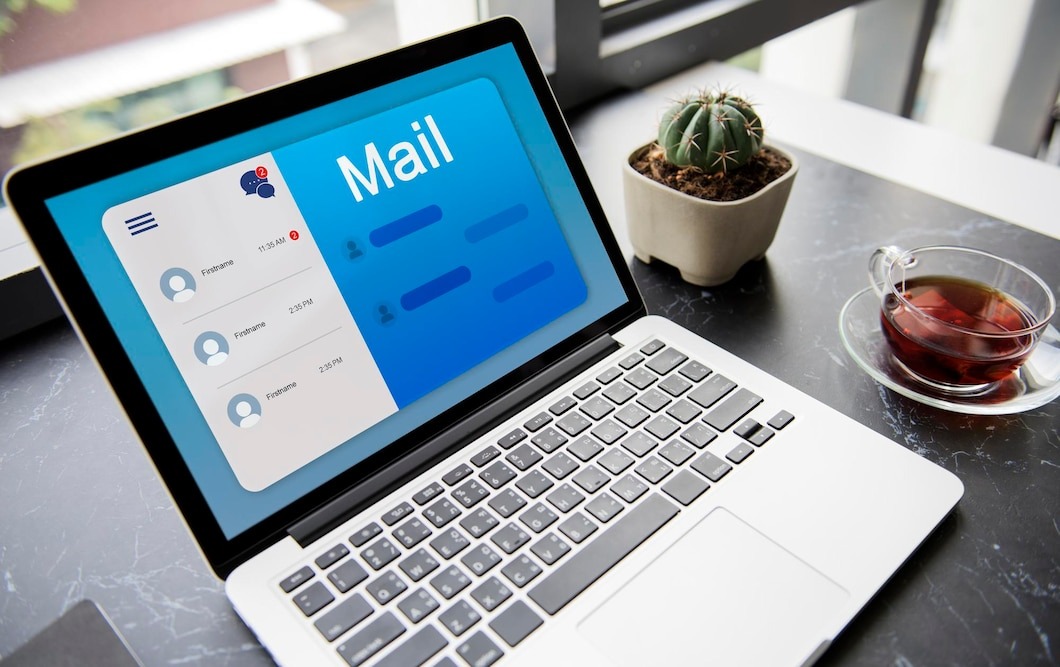
Why does email design matter?
- Aesthetic Appeal: Customers first notice the design when they open your email. A visually appealing email is more likely to be engaging and memorable.
- Brand Consistency: A well-designed email template helps maintain brand consistency. It reinforces your brand’s identity and assures customers that the email is from your store.
- Effective Communication: Design can enhance your message. It allows you to showcase the abandoned cart items effectively and create a compelling layout that guides the reader toward the desired action, such as clicking the CTA button.
- CTA Placement: An effective email template offers flexibility in placing CTAs. You can position them strategically within the email to maximize click-through rates.
When designing your abandoned cart email templates, consider factors like color schemes, fonts, and the overall layout. Ensure your templates are mobile-responsive since many customers check their emails on smartphones.
2. Personalize Everything
Personalization is a key element of successful abandoned cart emails. Customers want to feel valued, and personalized emails demonstrate that you care about their shopping experience.

How to personalize abandoned cart emails effectively:
- Use the Customer’s Name: Start by addressing the customer by their first name. Including their name in the email subject line can be incredibly effective.
- Create Compelling Subject Lines: Craft subject lines with the customer’s name and grab their attention. Stand out from the crowd with subject lines like, “Hey, [name]! Did you forget something?”
- Tailor Product Recommendations: In your email, suggest related or complementary products based on the items left in the cart. This shows that you understand their preferences and can lead to additional sales.
- Personal Touch: Keep the tone of your email personal and engaging. Use language that resonates with your audience, and avoid sounding overly formal or generic.
3. Write An Amazing Copy
An abandoned cart email is only as effective as its copy. The email copy lets you connect with the customer and persuade them to complete their purchase.

What Makes for an Effective Email Copy?
- Catchy Subject Line: As mentioned earlier, a catchy subject line is crucial to pique the recipient’s interest and encourage them to open the email.
- Compelling Content: Your email copy should be compelling, informative, and persuasive. Please explain why the customer should complete their purchase and how it benefits them.
- Product Details: Provide details about the abandoned products, including images, descriptions, and prices. Make it easy for customers to recall what they left in their cart.
- Create Urgency: Use language that creates a sense of urgency. Let the customer know how many abandoned products are in stock. Consider adding a limited-time coupon as an incentive.
4. Schedule Those Abandoned Cart Email
The timing of your abandoned cart emails can significantly impact their effectiveness. Sending them at the right time and in a well-structured sequence is essential.

Why Timing Matters:
- Immediate Follow-Up: Send the first abandoned cart email shortly after the customer abandons their cart, ideally within an hour. This prompt follow-up reminds them of their interest.
- Subsequent Emails: Send additional reminder emails at appropriate intervals, such as 10-12 hours after the first email and a final reminder 24 hours later. This sequence provides customers with multiple opportunities to return to their cart.
- Balancing Act: Finding the right balance is crucial. Waiting too long may cause the customer to lose interest while sending emails too frequently can come across as overly aggressive or pushy. By strategically timing your abandoned cart emails, you maximize your chances of re-engaging customers and recovering potentially lost sales.
5. A/B Test Email Campaigns
A/B testing is a valuable tool in your Shopify abandoned cart email strategy. It allows you to fine-tune your emails for optimal performance.
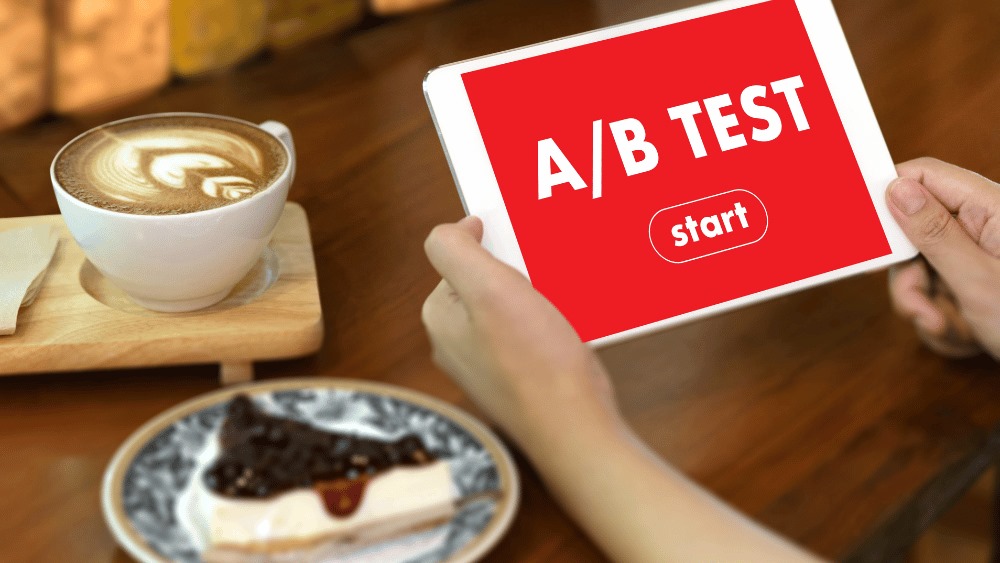
What to A/B Test:
- Subject Lines: Test different subject lines to determine which ones yield higher open rates.
- Email Templates: Experiment with various email templates for the most effective design.
- CTA Buttons: Test different CTA button text, colors, and placements to optimize click-through rates.
- Email Copy: Test variations of your email copy to see which resonates best with your audience.
- Segmentation: Consider segmenting your audience based on various factors, such as shopping behavior or demographics, and test different approaches for each segment. A/B testing provides valuable insights into what works and doesn’t, allowing you to improve your abandoned cart email campaigns continually.
6. Set Up Automation
Manually sending abandoned cart emails to every customer would be impractical and time-consuming. That’s where email automation comes to the rescue.
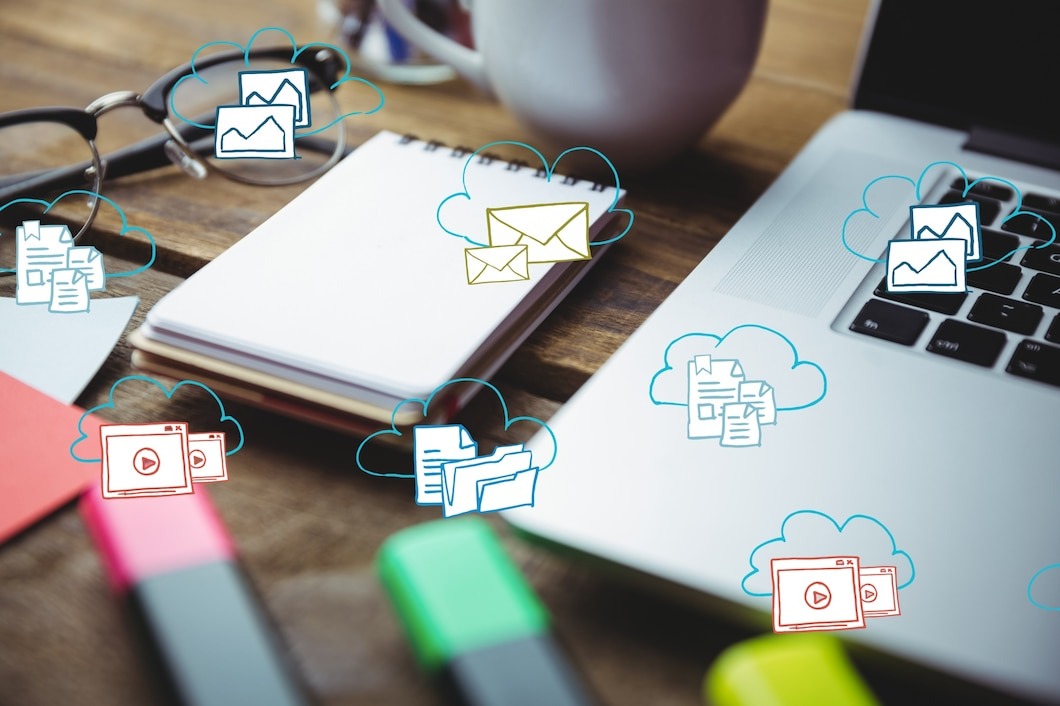
Why Use Email Automation:
- Efficiency: Automation streamlines the process, ensuring abandoned cart emails are sent promptly and consistently.
- Workflow Creation: You can create automated workflows or sequences that trigger abandoned cart emails based on specific actions or time intervals.
- Personalization: Automation allows for personalized messages and product recommendations without manual intervention.
- Follow-Up: With automation, you can follow up with customers who have abandoned their carts and continue to engage them until they complete their purchase.
To set up email automation for abandoned cart recovery:
- Choose the right email marketing tool that offers automation features.
- Create workflows (sometimes called recipes) for abandoned cart emails.
- Specify the desired action that ends the workflow (e.g., completing the purchase).
- Set the time intervals for email sending, following the recommended timing sequence.
- Include conditions to restart the workflow if the cart is abandoned again.
You can consistently and effectively recover lost sales without manual effort by setting up and activating automated abandoned cart emails.
7. Structure your email copy well
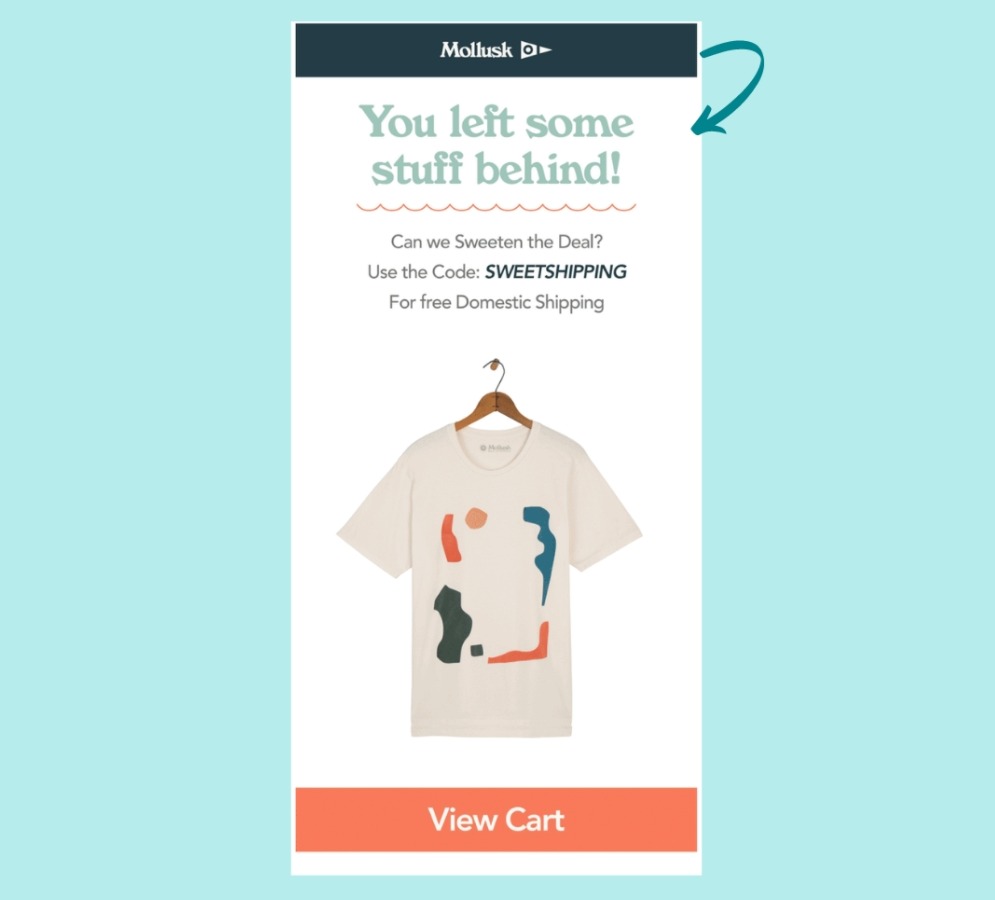
A captivating abandoned email copy practically compels users to return to your site and complete their transaction. Though it is difficult to predict customer behavior and email usability, you can certainly study it and gain valuable user insights.
Some of the requirements for a good abandoned cart email are as follows:
-
A catchy title (or subject line)
-
Excellent graphics and pictures
-
Copy that is compelling
When It comes to playing with the structure of the email’s copy, make sure that you know your main objective of the email - making users complete their purchases.
You need to understand that your recipients did show interest in the product they left behind, but for some reason could not complete the purchase. So your copy will oblige them to return and finish buying the product. This mindset will be the guideline that your email copy needs.
Also, don’t forget about your email’s CTA (call to action) button. The best way to use CTAs is to keep them simple. As in really simple. A clear, low-friction call-to-action fulfills the objective well. Don’t be overly aggressive with your CTA messaging, and don’t come out as too authoritative. Furthermore, you should not simply fill your entire email with many CTAs.
The most typical CTA phrases are “Return to Cart,” “Check Your Favorites Again,” “Complete Your Order,” and so on.
An engaging email copy contains all of the key ingredients while being uncomplicated and easy on the viewer’s eyes. These abandoned cart emails have a better probability of re-engaging the consumer and convincing them to complete the purchase. Also, you will strengthen your branding by keeping a good and consistent copy.
8. Try highlighting just one single product
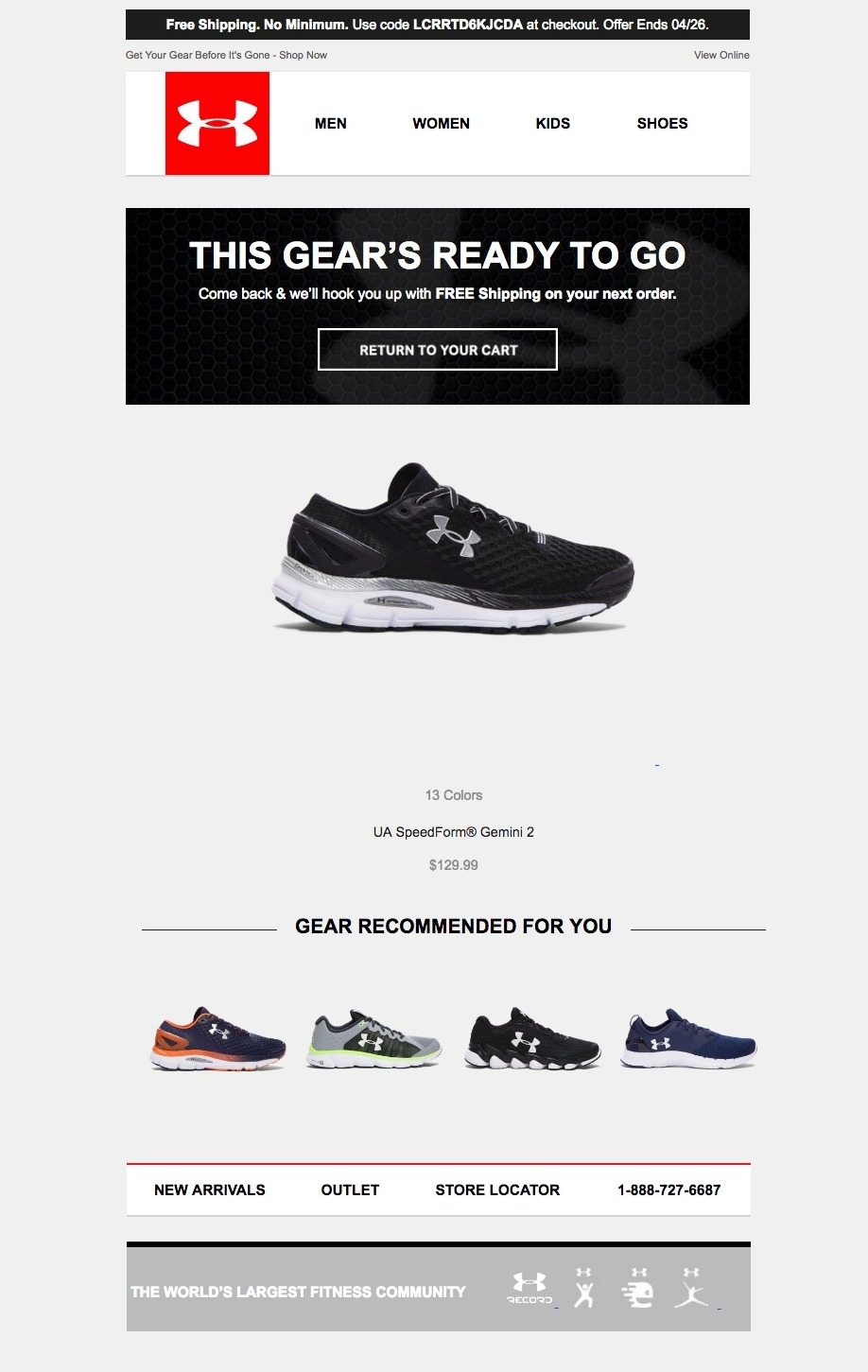
Many online customers now engage in a digital version of window shopping, adding various things to their cart for future consideration.
It’s safe to infer, however, that when someone adds ten very identical things to their cart, they don’t have equal purchasing intention for all of them.
Most abandoned cart emails, on the other hand, often remind the customer of all of the products in the cart, diluting the impact of your communication.
Instead of using that short period to re-market and re-sell your consumer on a single product (ideally the one they are most likely to buy), you (and others) use it across ten different products.
I’d like you to consider what a one-on-one conversation with that consumer may look like and how you might apply some fundamental sales concepts to boost your conversion rate. Here are three ways to turn your abandoned cart email into a better sales pitch:
-
Use at least part of your cart abandonment email campaign to sell one single product, and then really throw the spotlight on that product. The simplest method to accomplish this is to place your best-selling/highest-rated product in the cart, as it has converted for many of your previous customers.
-
Once you’ve narrowed your emphasis to a particular product, highlight some of its major benefits. Instead of utilizing generic marketing content that is relevant to your brand, you can highlight the product’s unique selling propositions (USPs).
-
Along with that, use your marketing language to emphasize on why the customer should complete their purchase. You can also provide some objectivity by adding recent product reviews. The combination of your and your potential customer’s words will provide your prospective customer with all of the information they need to make an informed purchasing decision.
When you follow the steps above to create your abandoned email, the result can be striking.
9. Include social proof for more credibility
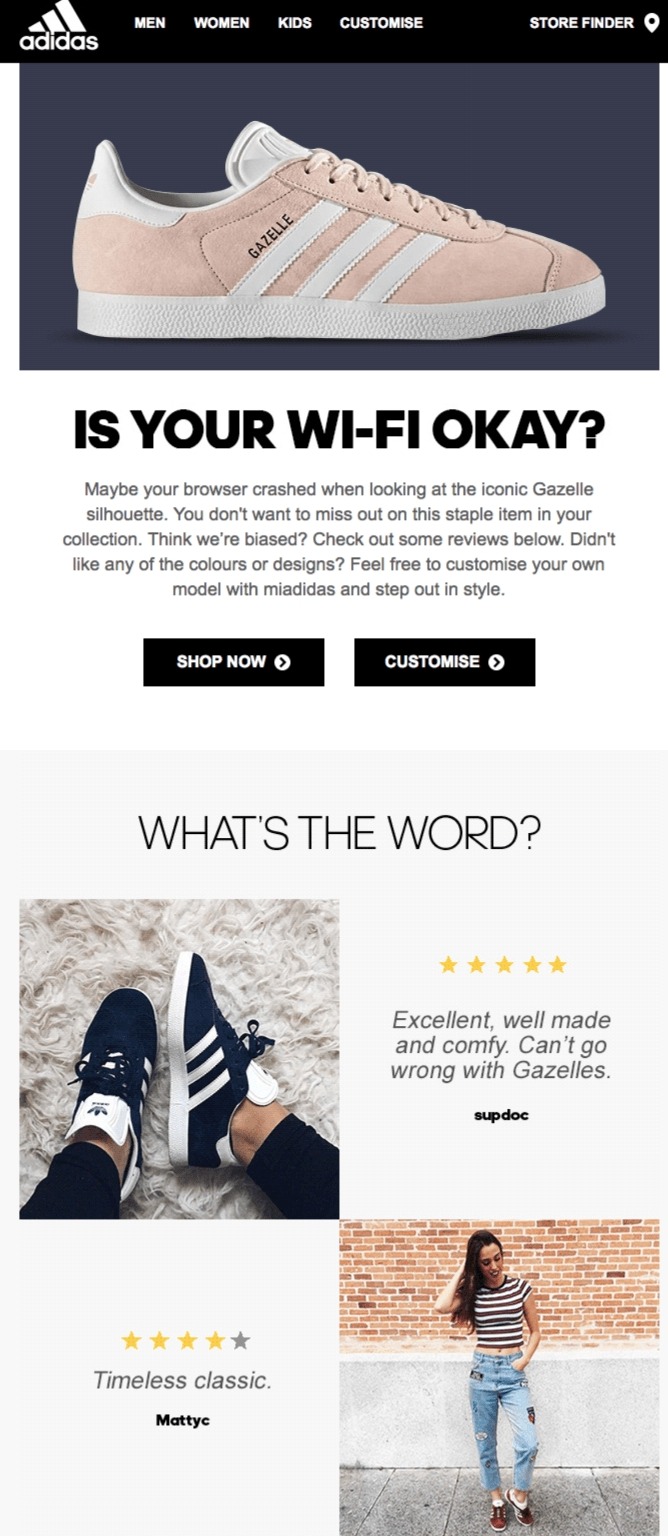
Gaining the trust of your customers and audience is a major objective for every organization. It establishes the foundation for a healthy business-customer relationship and fosters a positive bond. Users are more likely to be convinced and eventually convert if you have earned their trust.
It is highly advised that you include product reviews and ratings in your abandoned basket emails. This social proof tells users that they are in good company and will be purchasing a validated product that is trusted by many others.
When 94% of consumers said that positive reviews make them more likely to use a business, you have a huge opportunity.
Here are two ways to do that with your email marketing campaigns:
-
Contain a list of the products that were left in the cart: These emails include all of the expected information, such as the product name, image, and price. You may make your products more appealing by including the number of reviews as well as the average rating. Seeing something like “Rating: 4.64/5 (67 Reviews)” can give you an instant dose of FOMO and make buyers want to make that purchase right away.
-
Remind your customers that they have high-rated items in their shopping basket. You can enhance your open rates by including the star rating (of the highest rated product in the cart) in the subject line (something like “There are best-seller products in your cart!”).
10. Make use of loyalty
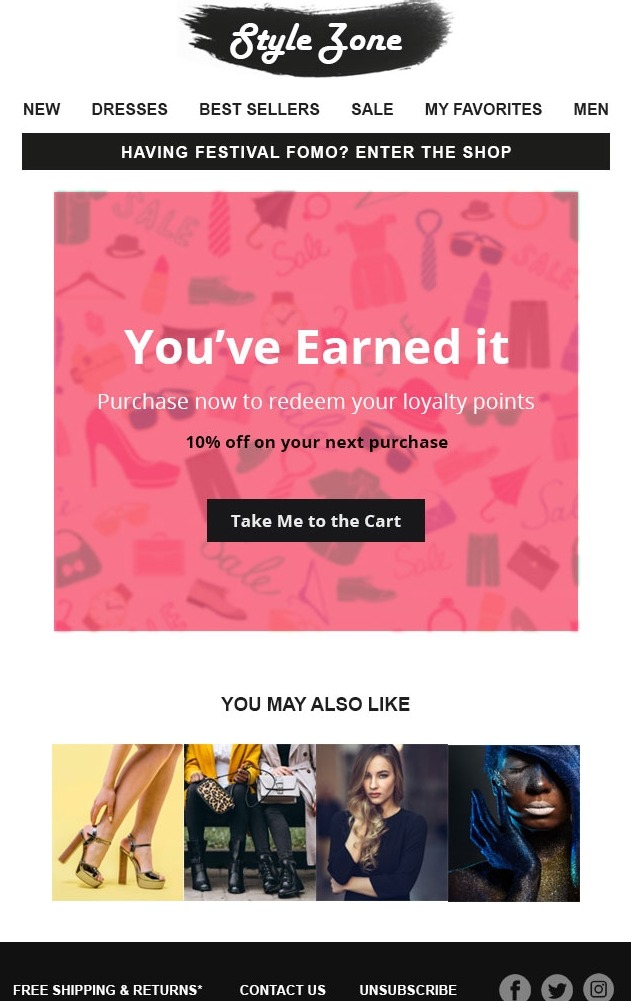
One of the most common tactics for recovering abandoned carts at the moment is to add a discount coupon, but because it’s such a common technique, many of the customers have come to expect it.
Discounts eventually reduce your profit margins and lose their effectiveness over time. The greater danger here is that frequent discounting devalues your goods over time. And when it comes to your most loyal consumers, discounts are particularly counter-intuitive.
The better way to do this is to make use of your loyalty or rewards program. Here is how you can apply this abandoned cart email strategy:
-
Create a loyalty program for your customers: What you want to determine is the number of points a member needs to get the reward (for example, a 10% discount). You can calculate this based on the average order value of your customers.
-
Create a segment for loyal customers in your email marketing app: This segment should include customers based on their spending. For example, when customers pay more than 200$, they get 100 points and a %10 discount.
-
Create an email campaign for the segment: This segment should receive different emails from average customers. You shouldn’t say they receive a discount, instead highlighting the fact that they have loyalty points that they can apply for a 10% off their cart.
Not only will this tactic convert well, your recovery rate will be boosted as well without you sounding like giving a discount to every cart abandoner. You are instead inviting your loyal customers to spend the points they have earned. This will also encourage your website visitors to create an account to see their points balance and the loyalty program.
11. Optimize your emails for mobile

When it comes to abandoned cart emails, providing a decent user experience on mobile becomes even more critical. We would say it’s critical for all types of emails, but since so many are checking their mails on smartphones, you’d better apply this strategy for a better open rate.
With the rise of smartphones, email open rates on mobile have surpassed email open rates on desktop. As a result, brands must optimize their emails for re not doing it, you can gain an advantage for your abandoned cart email by doing this.
When you send someone an email, there’s a good chance they’ll check it on their phone first. And if it isn’t mobile-friendly, you’ll lose a potential consumer right away.
Here is a list of things you can do to improve the appearance of your abandoned cart emails on mobile:
-
Put your key content and call-to-action (CTA) at the top of the page and make it easy to browse.
-
A responsive design within a single column is ideal.
-
Use photos and graphics that are mobile-friendly and don’t take long to load.
-
To cover up incompatible fonts and retain design consistency, use email-safe fonts with a good fallback font.
-
Include a descriptive alt text for the photos for users who block images. Especially when graphics are used to express your point.
-
Include a CTA button that follows the scroll to achieve a high recovery rate.
Smartphones are increasingly being used to access email. An abandoned cart strategy for mobile email provides you a competitive advantage and makes your communications more attractive.
12. Maintain a long-term relationship
Many eCommerce stores quickly set up abandoned cart emails for first-time shoppers, but this can be counterproductive. With compliance laws like GDPR and DMARC, it is essential that you get consent from consumers before sending marketing emails.
So, we can agree that a smaller and more engaged email list will win over a bigger email list but disengaged audience. You should make sure that your abandoned cart email strategy focuses on people who want to receive messages from you, as well as intend to buy from you.
The context you should consider is that it is not always possible for the buyer to make a purchase immediately away.
Perhaps they should save up a little more, or they are purchasing a gift that they will only need later.
In certain circumstances, you want to keep the connection open until they are ready to make a purchase. One method is to include a final email in your abandoned cart email sequence inviting your prospect to instead join your mailing list for other deals.
This way, they may not purchase the cart, but you can trigger other automated campaigns for them, such as regular newsletters, new promotions, relevant products, or simply wish them a happy birthday.
Because, at the end of the day, it’s even more beneficial to keep you on top of the consumers’ minds and at some point, a part of them will start making purchases anyway. You can consider this “indirect abandoned cart recovery” strategy.
Tips for creating Shopify Abandoned Cart Email
1. Select a Platform with Built-In Abandoned Cart Email Features:
As a popular e-commerce platform, Shopify offers built-in abandoned cart email features. Utilize these features to set up your abandoned cart email campaigns effortlessly. The platform provides templates and automation tools to get you started.
2. Craft a Clear and Friendly Message:
Keep your message simple and friendly. Remind customers about their abandoned items and let them know you’re here to help. Avoid jargon or complex language; aim for a straightforward and warm tone.
3. Include a Strong Call-to-Action (CTA):
Your email should have a clear CTA button directing customers to their abandoned carts. Use simple, action-oriented language on the button, like “Complete Your Purchase” or “Return to Cart.”
4. Offer an Incentive:
Encourage customers to return to their cart by offering a small incentive, such as a discount or free shipping. Use simple terms to explain the benefit, like “Get 10% Off” or “Enjoy Free Shipping.”
5. Keep It Mobile-Friendly:
Many customers check emails on mobile devices. Ensure your abandoned cart emails are mobile-responsive, meaning they look good and function well on smartphones and tablets. This ensures a smooth shopping experience for all customers, regardless of their device.
4 Popular Shopify Abandoned Cart Email Real Examples
Rudy’s Abandoned Cart Email
Let’s start with Rudy’s. Their abandoned cart email exemplifies many of the essential elements of an effective Shopify abandoned cart email.

The Basics
Rudy’s takes a minimalist and basic approach to their email template, and this simplicity works to their advantage. The product images and descriptions stand out, making it easy for customers to see what they left behind.
The Attention-Grabbing Copy
The email starts with an attention-grabbing copy reminding subscribers about the ‘free shipping’ offer, emphasizing its imminent expiration. This plays into the Fear Of Missing Out (FOMO) phenomenon, a powerful motivator for potential customers.
Product Details and Clear CTA
Rudy includes the abandoned product’s images, details, and a clear Call to Action (CTA) button, encouraging the subscriber to take action. Furthermore, they sweeten the deal by offering a coupon code, providing that extra incentive needed to purchase.
Social Proof
Rudy’s incorporates social proof into their email, showcasing customer ratings and reviews. This helps build credibility and trust with the customer, as they can see that others have had positive experiences with the brand.
Witty Copy
Rudy uses a touch of wit in their copy, saying, “Don’t put this off like a software update.” This relatable language adds a human touch to the email and is likely to catch the eye of subscribers. In summary, Rudy’s Shopify abandoned cart email is visually appealing and challenging to ignore. It effectively combines attention-grabbing copy, product details, a clear CTA, social proof, and relatable language to engage potential customers.
Only Curls’ Abandoned Cart Email
Let’s look at Only Curls’ abandoned cart email, which offers a different approach but is equally effective.
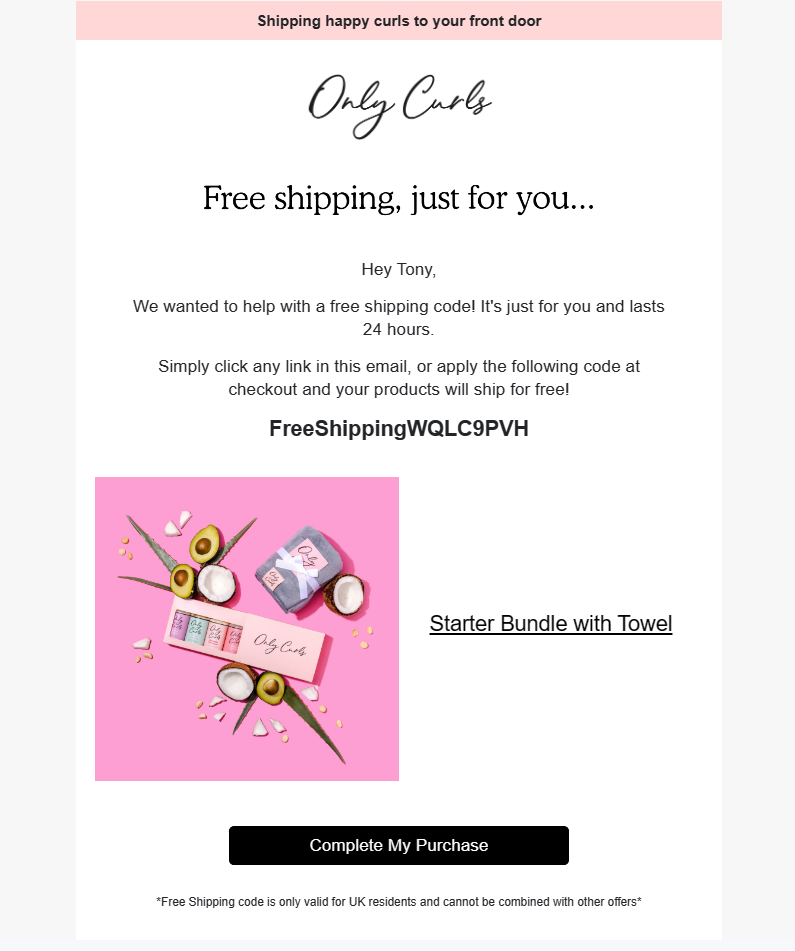
Personalized Message
Only Curls starts by personalizing their message, thanking the reader for visiting their online store. This establishes a strong sense of communication between the brand and the audience. Their message is longer than your typical abandoned cart email, creating a friendly and personable image.
Product Recommendations

The email doesn’t just remind the customer of the abandoned product; it also suggests other products the specific buyer might be interested in. This proactive approach helps increase the chances of additional sales.
Showcasing Customer Ratings
Only Curls rounds off the email by showcasing the ratings they’ve received from customers. Including reviews in your abandoned cart email not only builds credibility for your brand but also reassures potential customers about the quality of your products.
In summary, Only Curls’ abandoned cart email is a prime example of personalization and product recommendations. It establishes a friendly tone, suggests relevant products, and uses customer ratings to build trust.
Munio’s Abandoned Cart Email
Munio’s abandoned cart email combines the best elements of Rudy’s and Only Curls’ approaches, creating a compelling email that engages potential customers.
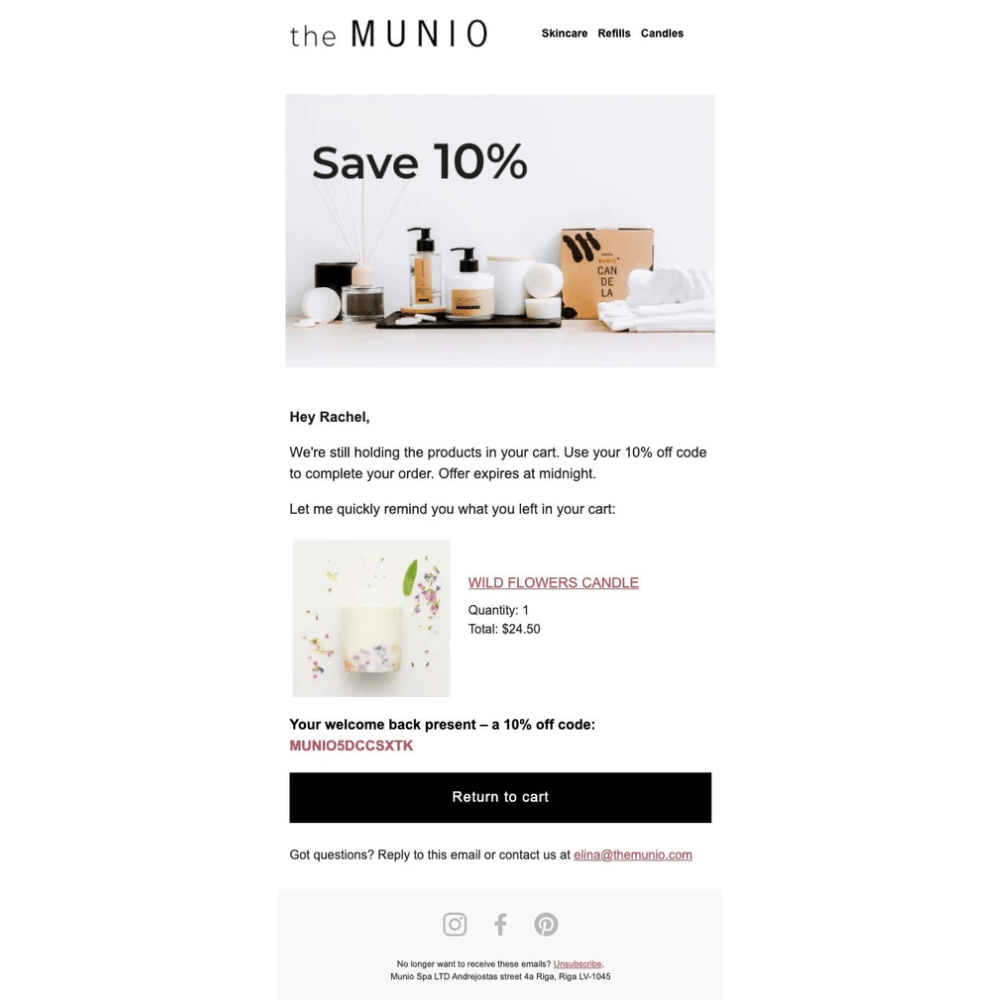
Irresistible Offer
Munio starts by offering the subscriber a 10% discount on the abandoned product and a sense of urgency by mentioning that the offer expires at midnight. This not only provides an incentive but also taps into the FOMO phenomenon.
Personalization
The email takes personalization to the next level by addressing the subscriber by their first name. It goes the extra mile to make the customer feel special, and this personal touch can go a long way in retaining their interest.
Saving the Product
Munio also attempts to gain the customer’s loyalty by telling them they’ve saved the abandoned product just for them. This level of attention and care can significantly impact the customer’s perception of the brand.
Munio’s abandoned cart email is a powerful combination of a compelling offer, personalization, and the promise of exclusivity. It leverages the fear of missing out while making the customer feel valued.
Adidas’ Abandoned Cart Email
Adidas, a global giant in the world of sportswear, is good for email marketing. Their abandoned cart email is a prime example of how a well-known brand can effectively use email to recover potentially lost sales.
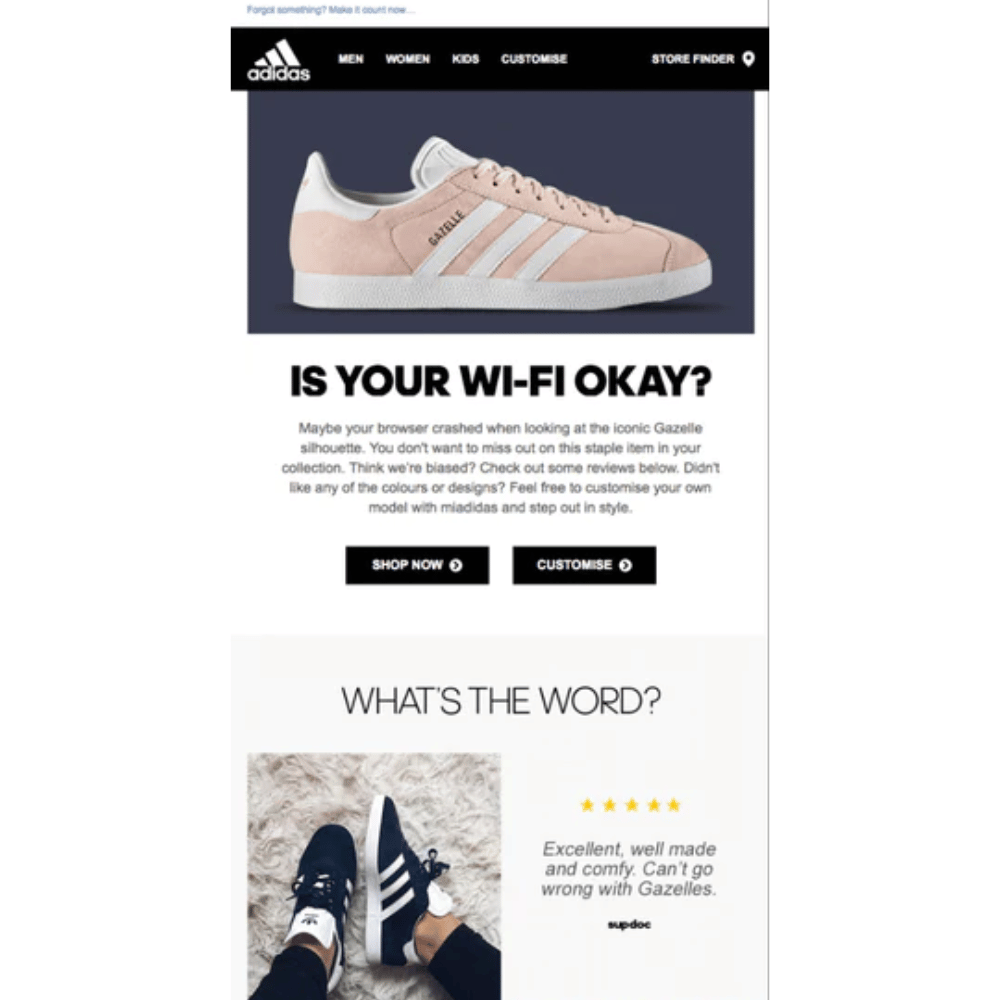
Minimalistic Brand Colors
Adidas sticks to its minimalist black and white brand colors in the email template, ensuring the focus remains entirely on its product. The simplicity of the design makes the product even more alluring.
Engaging Copy
Adidas takes a direct approach by asking the subscribers what happened and why they left a fantastic product without completing the purchase. This engages the customer by prompting them to consider their actions.
User-Generated Content (UGC)
The email features genuine customer testimonials, highlighting user-generated content. This addition adds value to the product and can encourage potential customers to purchase without a second thought. Adidas’ abandoned cart email showcases the power of a well-established brand. It relies on a minimalist design, engaging copy, and user-generated content to recover potentially lost sales.
Additional resources for abandoned cart emails
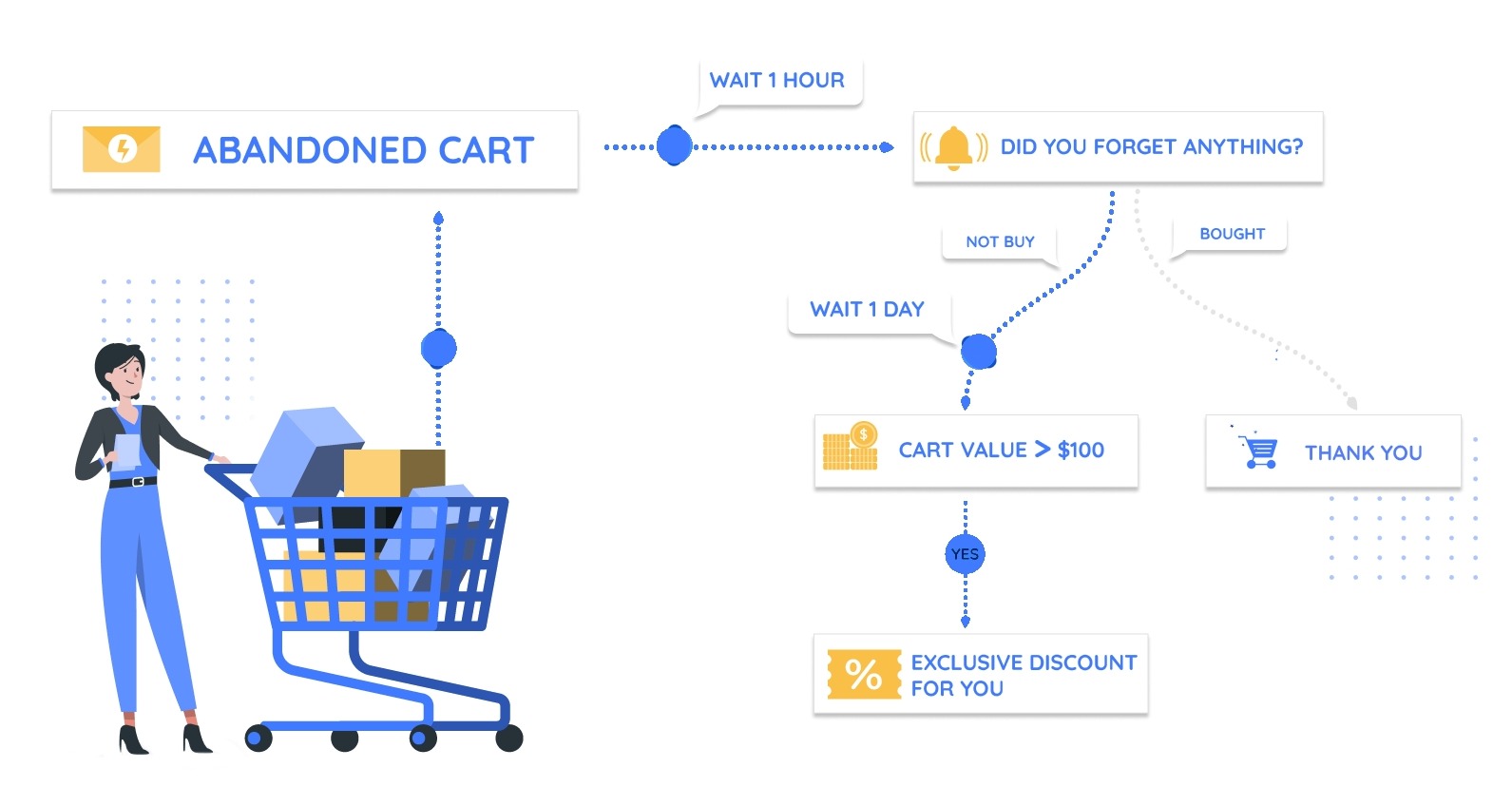
Here at AVADA, we just love to explore more on abandoned carts. In fact, our abandoned cart email template inside AVADA Marketing Automation is one of the most used for our users. By using our email editor, they can design emails with reviews, upselling items, coupons, etc. to increase the recovery rate.
So, the first resource that you should consider for your abandoned cart strategy is AVADA Marketing Automation - a powerful email and SMS marketing platform that allows you to create automated campaigns with highly-customization. With the help of segmentation and valuable data, you will be able to implement your cart abandonment email strategy without a sweat.
Also, check out these other articles:
-
Here are 99+ best subject lines for abandoned cart emails to increase the open rate.
-
Here are 10 awesome abandoned cart email templates for Shopify stores.
-
Here are 12 best practices for abandoned cart email that you should copy.
-
Last but not least, here is a detailed guide on abandoned cart email (bonus on how you can create an abandoned cart email automated campaign with our app).
Final words
Having a strategy is often just the first step. There will be many things that you should look out to improve your abandoned cart email campaigns and increase the recovery rate. Following up on lost sales is critical for an eCommerce brand, and we’re sure if you have read this far, you have more than enough will to make your brand a success.
Start implementing your own abandoned cart email strategy today, and tell us your result in the comment section. If we miss out on any strategy that you are using, we’d love to know too! Anyway, thanks for reading, and best of luck with your email campaigns!
FAQs
New Posts






